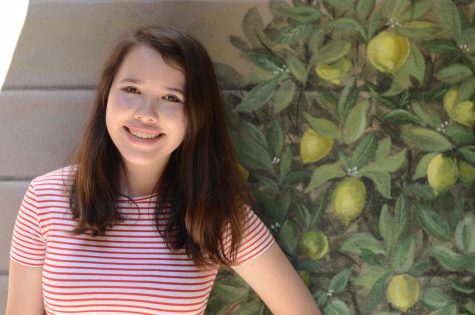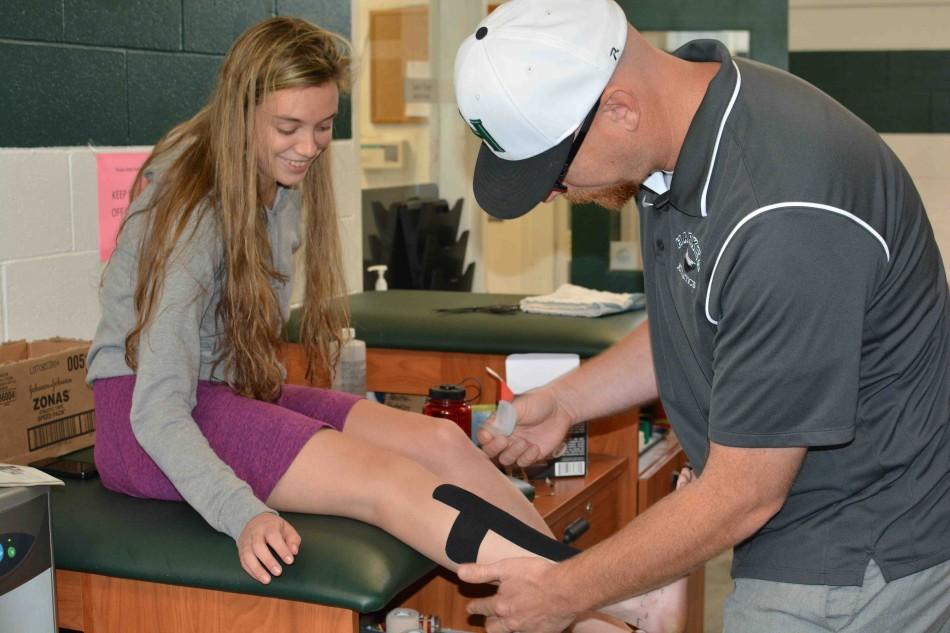Q & A with Jaron Olson on sports medicine
Jaron Olson helps Julia Fink (11) with her strained leg. This, among others skills, will be taught in his sports medicine class next year.
The Upper School is offering a semester-long sports medicine class for the first time next year. Jaron Olson, the Upper School’s athletic trainer, proposed the class last fall.
“Mr. Keller was very supportive,” he said. “I’ve been working with Ms. Gargano on getting the course developed.” The class, which is not worth PE credit, is presently going through the UC course approval procedure, a process that should be completed by this summer. Currently, the class is open for enrollment.
Harker Aquila: Why did you decide to create your Health Medicine class?
Jaron Olson: I wanted to develop the Kinesiology and Sports Medicine class so students would have an opportunity to learn more about the fields of study and occupations that fall under the umbrella of Kinesiology. That includes fields related to human performance, such as Exercise Physiology, Biomechanics, as well as health care careers including athletic training, physical therapy, chiropractic, medicine, etc.
HA: What will be covered in this class?
JO: We will look at concepts including functional anatomy, movement analysis, recognition and treatment of common athletic injuries, protective taping and other injury prevent techniques, and a whole lot more.
HA: What has the response been to your class?
JO: The response has been great, so far over 30 students are enrolled, enough for two sections of the class. I knew we had lots of students who would be interested in these topics, but I was not exactly sure how many would actually enroll, so I was very pleased at the response.
HA: How many credits is it worth?
JO: The standard ½ unit per semester.
HA: How many semesters is it?
JO: We will actually have two semester long courses. Basically, level I and level II. That way students who are excited about the subject material can take the year long course. But it also allows students who want to take a different elective in the spring semester to do that as well.
HA: Can you give an example of the kind of work your students will be doing this coming year?
JO: Each unit will be a little bit different, however, my goal is for much of the class to consist of hands on learning. We will have many lab activities where we will learn and practice practical skills. Projects will include injury case studies, as well as presentations on a specific field of study each student is interested in, splinting/spine-boarding, ankle taping. As part of the unit on “Responding to Emergencies”, students will also earn certification in First Aid, CPR, and AED (automated external defibrillator).
HA: What do you hope your students will get out of your class?
JO: I hope some students will learn more about a field of study that intrigues them. I knew very little about the field of Kinesiology prior to entering college, I didn’t even know the profession of athletic training existed. So I hope students will gain an appreciation for the topic, regardless of what type of careers they end up pursuing. The great thing about this class, I think, will be that whether or not students end up entering a Kinesiology or Sports Medicine related field, these are concepts and skills that will be valuable for them. Useful information for anyone who is physically active, anyone who ends up coaching their kid’s youth soccer team, or anyone who is just fascinated by the human body.

Meilan Steimle (12) is co-Editor-in-Chief of the Winged Post. She was a reporter her freshman year, Winged Post Opinion Editor her sophomore year and Winged...


















![“[Building nerf blasters] became this outlet of creativity for me that hasn't been matched by anything else. The process [of] making a build complete to your desire is such a painstakingly difficult process, but I've had to learn from [the skills needed from] soldering to proper painting. There's so many different options for everything, if you think about it, it exists. The best part is [that] if it doesn't exist, you can build it yourself," Ishaan Parate said.](https://harkeraquila.com/wp-content/uploads/2022/08/DSC_8149-900x604.jpg)




![“When I came into high school, I was ready to be a follower. But DECA was a game changer for me. It helped me overcome my fear of public speaking, and it's played such a major role in who I've become today. To be able to successfully lead a chapter of 150 students, an officer team and be one of the upperclassmen I once really admired is something I'm [really] proud of,” Anvitha Tummala ('21) said.](https://harkeraquila.com/wp-content/uploads/2021/07/Screen-Shot-2021-07-25-at-9.50.05-AM-900x594.png)







![“I think getting up in the morning and having a sense of purpose [is exciting]. I think without a certain amount of drive, life is kind of obsolete and mundane, and I think having that every single day is what makes each day unique and kind of makes life exciting,” Neymika Jain (12) said.](https://harkeraquila.com/wp-content/uploads/2017/06/Screen-Shot-2017-06-03-at-4.54.16-PM.png)








![“My slogan is ‘slow feet, don’t eat, and I’m hungry.’ You need to run fast to get where you are–you aren't going to get those championships if you aren't fast,” Angel Cervantes (12) said. “I want to do well in school on my tests and in track and win championships for my team. I live by that, [and] I can do that anywhere: in the classroom or on the field.”](https://harkeraquila.com/wp-content/uploads/2018/06/DSC5146-900x601.jpg)
![“[Volleyball has] taught me how to fall correctly, and another thing it taught is that you don’t have to be the best at something to be good at it. If you just hit the ball in a smart way, then it still scores points and you’re good at it. You could be a background player and still make a much bigger impact on the team than you would think,” Anya Gert (’20) said.](https://harkeraquila.com/wp-content/uploads/2020/06/AnnaGert_JinTuan_HoHPhotoEdited-600x900.jpeg)

![“I'm not nearly there yet, but [my confidence has] definitely been getting better since I was pretty shy and timid coming into Harker my freshman year. I know that there's a lot of people that are really confident in what they do, and I really admire them. Everyone's so driven and that has really pushed me to kind of try to find my own place in high school and be more confident,” Alyssa Huang (’20) said.](https://harkeraquila.com/wp-content/uploads/2020/06/AlyssaHuang_EmilyChen_HoHPhoto-900x749.jpeg)



